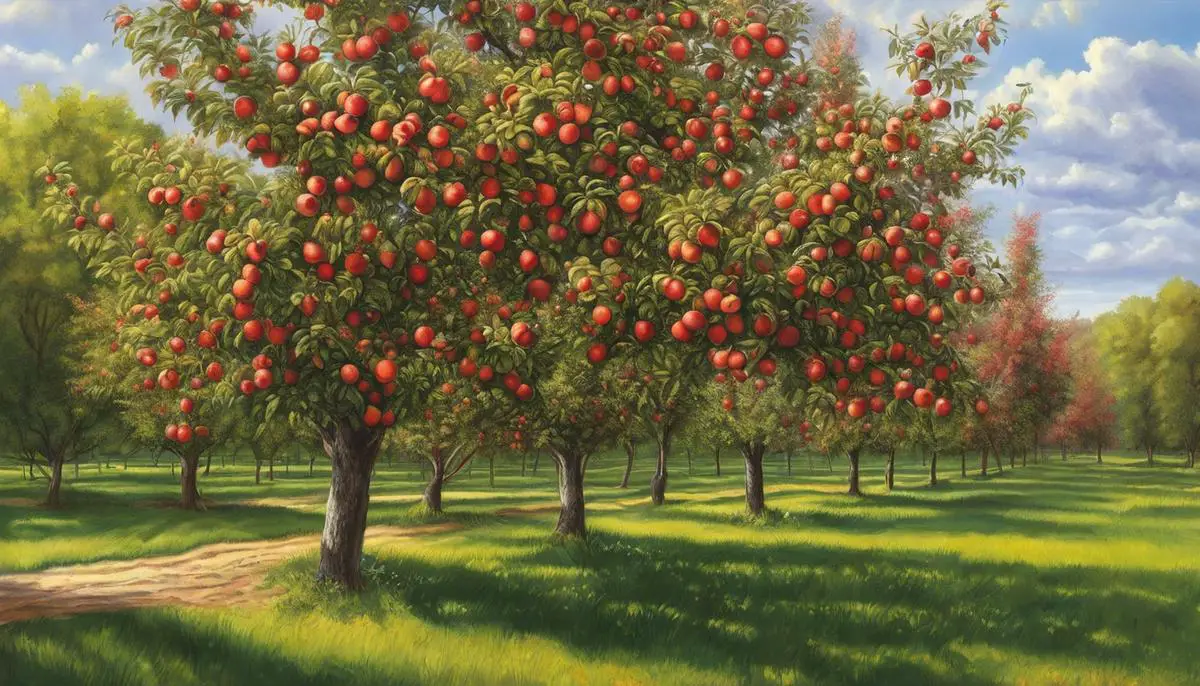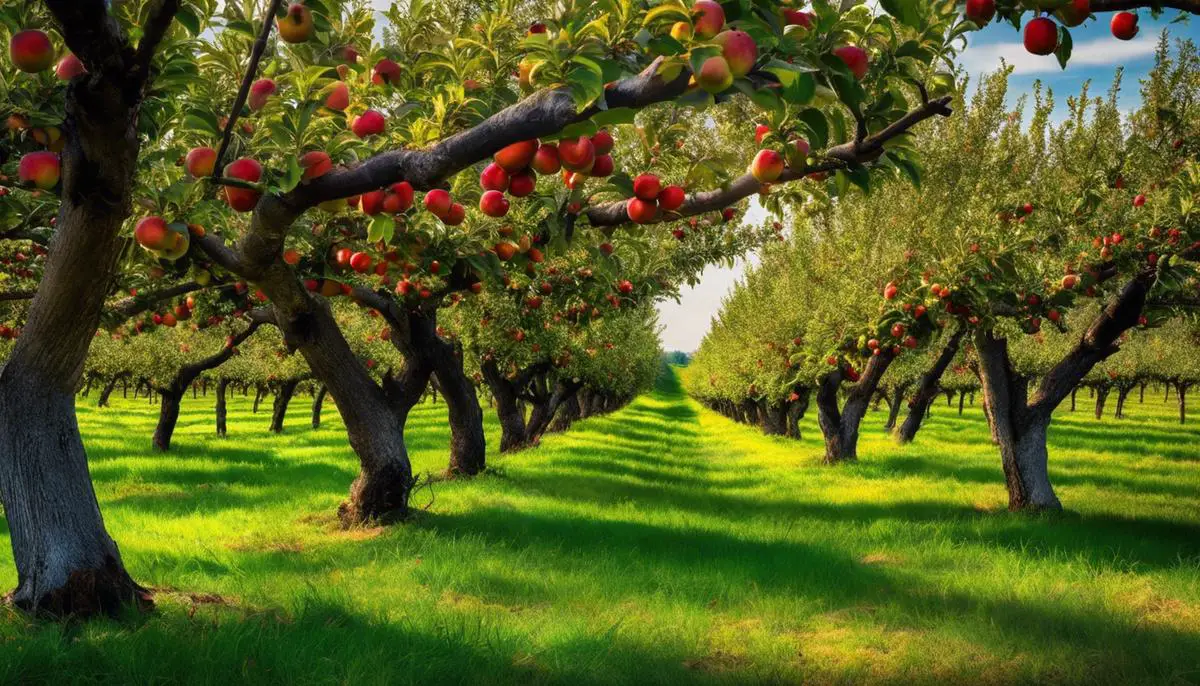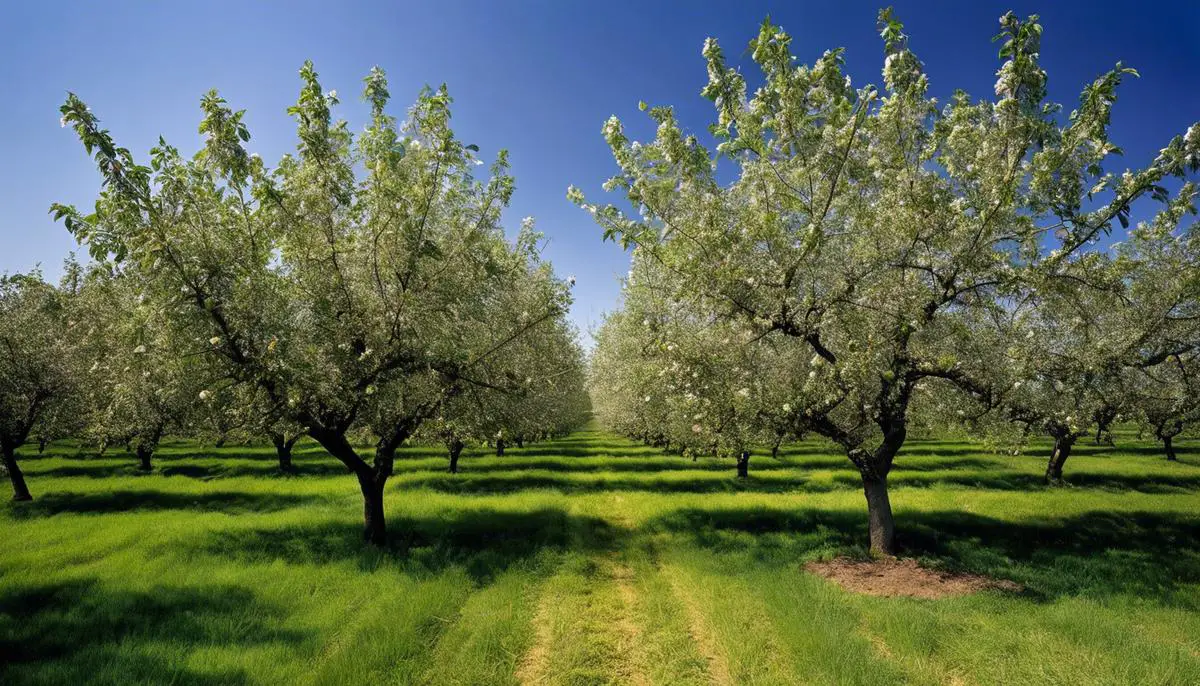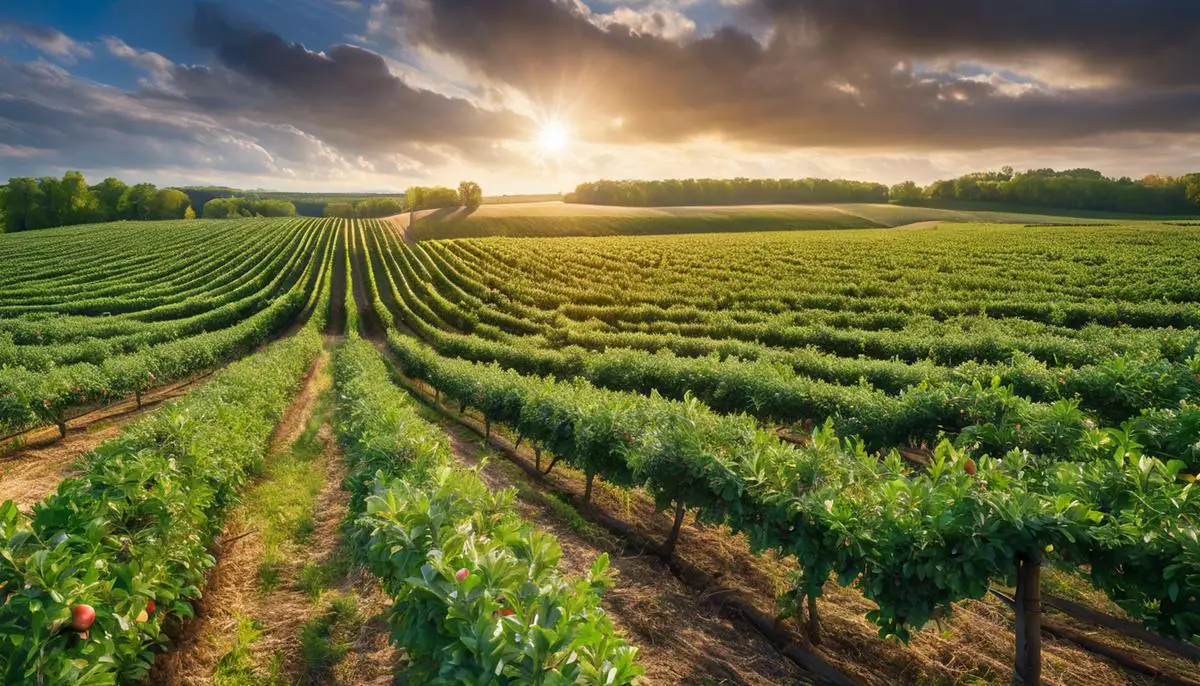Indiana, nicknamed “The Hoosier State,” is not only renowned for its vast agricultural land but also for its diverse variety of apple trees that underpin its vibrant apple industry. The state’s diverse apple tree species, such as the Golden Delicious, Honeycrisp, Braeburn, and Spencer apple, each hold unique characteristics specific to the region’s climate, and they serve as mainstays in the horticultural landscape and the economy. This discourse explores these apple tree species in the context of their propagation and management protocols, while assessing the measurable economic impact of the apple industry to Indiana’s growth. Furthermore, this discussion delves into how Indiana’s typical climate molds the apple trees’ growth and the subsequent influence on the yield.
Species Variation of Apple Trees in Indiana
An Examination into the Edibles: Discovering the Native Apple Tree Species of Indiana
Subheading: A Comprehensive Journey into the Pomological Profusion of Indiana
The ecological and geographical diversity of Indiana has given birth to a commendable variety of flora and fauna – an arena that effortlessly galvanizes the scientific curiosity towards an enlightening exploration. Among the cornucopia of botanical treasures Indiana is endowed with, one noteworthy kind is the humble apple tree. The focus here is directed towards unearthing and understanding the apple tree species indigenous to Indiana.
Apple trees, scientifically classified under the genus Malus, are widely cultivated for their tasty and nutritious fruits. A surprising fact about these trees is the impressive range of different varieties that it comprises. In Indiana’s fertile lands, predominantly two species of apple trees have carved their niche – Malus coronaria and Malus ioensis.
Subheading: Malus Coronaria – The American Crabapple
Malus coronaria, also hailed as the American Crabapple or Sweet Crabapple, is a native apple tree species of Indiana. As a deciduous tree, this species typically grows in a round shape reaching up to a height of 6 – 12 meters. The leaves exhibit an inviting green hue during the summer, transforming into an appealing variety of yellows and reds as the autumn fills the air. Blooming in clusters of white-to-light pink flowers during the spring months, the Malus coronaria is not only strikingly beautiful but also a vibrant contribution to Indiana’s flora.
The fruit of Malus coronaria, known commonly as Crabapple, is smaller than the usual apple, but boasts a high pectin content. Although not favored for fresh consumption due to its tartness, it is highly prized for making jellies, sauces, and ciders.
Subheading: Malus Ioensis – The Prairie Crabapple
Indiana’s most iconic native apple tree is the Malus ioensis or the Prairie Crabapple. It flaunts outstanding springtime beauty when blanketed in blossoms of white and pinkish hues complemented by a subtle fragrance filling the air. Dwarfing its relative, the Malus coronaria, this species grows to lofty heights of up to 15 meters, boasting an imposing size.
The fruits of Malus ioensis, typically yellow-green, are similar in size to those of the American Crabapple. They possess a tart flavor profile, making them ideal for culinary purposes such as pie baking and preserves.
Apple trees native to Indiana are examples of the state’s diverse botanical assets. Although these species may not be on the commercial apple grower’s radar, for anyone interested in indigenous trees, these apple varieties present a fascinating study. Not only do they paint a beautiful picture in the landscape with their flourishing blooms and vibrant colors but their ecological importance cannot be underestimated. These native apple species provide food and shelter to an array of wildlife inhabitants, thus contributing significantly to biodiversity and supporting the overall health of Indiana’s ecosystems. Both Malus coronaria and Malus ioensis occupy the unique pedestal of indigenous species in the botanical heritage of Indiana, expressing a native narrative of biological richness and resilience.

Climate Influence on Apple Trees Growth and Development in Indiana
Delving into the correlation between Indiana’s climate and the evolution of apple trees, it’s indispensable to identify the primary climatic factors influencing these biological processes. Indeed, temperature, precipitation, and soil quality play an integral part in the flourishing of apple trees.
Indiana’s climate, classified as humid continental, exhibits moderate rainfall and temperature swings, making it conducive for horticultural success. The annual temperature ranges from 40°F to 76°F, fostering the growth and development of apple trees. A critical aspect to note is that apple trees necessitate a chilling period – cold temperatures for a designated span – to break dormancy and induce flowering, a process referred to as vernalization. Indiana’s winters, with average lows hovering around 18°F in the northern parts to about 28°F in the south, provide this obligatory chilling period.
Precipitation, another critical element, influences not just the growth but fruit yield of apple trees, with the trees requiring water throughout the growing season. Indiana’s average annual rainfall of approximately 40 inches offers the trees consistent hydration. Seasonally, spring and summer witness greater rainfall, aligning perfectly with the trees’ growth and fruit-bearing cycles.
Just as important is the local soil composition, often overlooked but critically playing a pivotal role. Indiana’s loamy soil, rich in organic content, offers a fertile ground conducive for root growth. The soil’s pH level, usually between 6.0 and 7.0, is ideal for nutrient uptake, ensuring a healthy growth phase.
Additionally, the state’s gentle topography aids in natural drainage patterns, maintaining the soil’s moisture balance and thwarting waterlogged soil conditions – both essential for apple tree vitality.
Climate impacts are not exclusive to the trees’ physical growth and fruit production; they extend to disease prevalence as well. Indiana’s climate conditions can lead to the prominence of certain apple pests and diseases, such as apple scab and codling moth.
Thus, the choreography between Indiana’s climate elements and apple tree biology creates a hospitable environment for these trees. This proactive relationship results in the trees’ successful growth, bountiful fruit yield, and enduring presence in Indiana’s diverse ecosystems.

Cultivation and Management Techniques for Apple Trees in Indiana
Expanding on the above concepts, the process of cultivating and managing apple trees in Indiana involves a meticulous approach. A combination of variables including the type of rootstock, desired scion variety, and the tree’s overall maintenance and protection contribute to the potential success of apple cultivation.
Regardless of whether the apple tree is Malus coronaria or Malus ioensis, the choice of rootstock strongly influences the tree’s size, adaptability to soil, disease resistance, and overall longevity. Rootstocks such as M.111 and M.7 possess a broad climate adaptability, vigorous growth, and good resistance to diseases, key traits for thriving in Indiana’s diverse ecology.
Our next point of focus is the scion, which determines the variety of apple produced. The potential combinations feasible with apple grafting in Indiana are numerous, offering the opportunity to grow desirable apple variants that best suit the specific conditions of the region.
A crucial consideration during the apple tree plant process is the tree’s spacing. It is vital to remember that trees grafted on M.111 rootstocks, for example, will grow larger and need at least 15 feet of open space around them. Trees on M.7 rootstocks are smaller in size and require roughly 12 feet. These measures help ensure the trees receive sufficient sunlight and airflow, thereby reducing the risk of disease.
Deep in analysis towards apple cultivation, we cannot overlook the importance of nutrient management. Regular soil testing will ascertain nutrient levels, providing a comprehensive understanding of any changes required in fertilizer application. While apple trees require a spectrum of essential nutrients, attention should be given to Nitrogen (N), Phosphorus (P), and Potassium (K) as they are crucial for tree growth and fruit development. Conversely, excessive Nitrogen can lead to sparse fruiting and increased susceptibility to diseases and pests.
Speaking of pests and diseases, both can pose significant challenges to apple cultivation. Common threats in Indiana include apple scab, fire blight, cedar-apple rust, codling moth, apple maggot, and plum curculio. Ever vigilant, an integrated pest management (IPM) approach is being suggested for effective control. This involves the routine monitoring of apple trees for signs of disease or pest activity and treating problems as they arise using the least harmful methods.
Additionally, pruning – the practice of selectively removing branches – aids in maintaining the tree’s health and maximizing the fruit yield. Notably, apple trees should be pruned in late winter to early spring to maintain optimal tree structure and light penetration necessary for bountiful harvests.
Regular irrigation, particularly during dry spells, ensures that apple trees receive the necessary water to promote growth and fruit production. However, timing and volume are critical; overwatering can lead to root disease and even tree death.
The importance of conducting annual tree inspections cannot be overemphasized. Tracking the growth and development of the apple trees, looking for signs of pests, disease, or other issues, is critical to maintaining a healthy grove.
In conclusion, the application of these cultivation methods and management techniques for apple trees in Indiana is not an arbitrary task but a careful orchestration of several factors working together. This knowledge, coupled with the shared practices and continued research, paves the way for the successful cultivation of apple trees in Indiana, contributing substantially to local ecosystems and biodiversity.

Economic Impact of Apple Trees in Indiana
Now that we have comprehensively explored the biodiversity, ecology, and cultivation practices related to apple trees in Indiana, let’s delve into the significant role they play in the state’s economy.
The business of growing apples in Indiana is certainly no small affair. According to the National Agricultural Statistics Service, Indiana’s apple orchards spread across approximately 2,500 acres, yielding around 1.7 million bushels of apples annually. Given the average marketplace value of apples, the annual revenue generated is quite considerable, contributing sizably to Indiana’s agricultural sector.
Moreover, apple cultivation isn’t just about direct revenue generated from fruit sales. The industry plays a pivotal role in job creation as well. From farm workers who tend to the fruit-bearing trees, professionals who handle the harvest, to individuals that manage transportation, sorting, packaging, and marketing of the apples – the ripple effect of employment opportunities is extensive. This sustains numerous livelihoods and positively impacts overall economic health.
An often overlooked but important component of apples’ economic contribution comes from Indiana’s booming cider industry. The increasing popularity of artisanal and locally sourced food and beverages has created a burgeoning market for cider producers. With Indiana apple orchards providing the essential raw materials, the cider market has witnessed strong growth, injecting a robust cash influx into the economy while promoting entrepreneurial endeavors and innovation.
Akin to cider, the apple processing industry, which includes apple juices, apple pies, applesauce, and other apple-based products, also adds considerable economic value. Local enterprises producing these goods are able to create value-added products that often have a higher profit margin than selling raw fruits. This results in increased revenue streams, bolstering the economic significance of apple cultivation in the state.
The tourism industry also experiences a spillover effect from apple cultivation. “Pick-your-own” apple operations, annual apple festivals, farm tours, and visits to cider mills draw tourists from near and far, amplifying tourism revenue.
The role of apples in Indiana’s economy extends to the domain of research and development as well. Universities and research institutions in the state continue to conduct apple-related studies, leading to innovations in disease resistance, improved cultivation practices, new apple varieties, and advancements in post-harvest technology, to name a few. This not only brings in research funding but also puts Indiana on the global map for apple-related expertise.
All these aspects point to the undeniable fact that apple cultivation contributes significantly to Indiana’s economy. The industry’s importance extends beyond the financial – it connects to culture, tradition, and an integral part of community life in the state. As science enhances our understanding and techniques of apple cultivation, so too will the economic benefits continuously unfold. The apple, indeed, holds a golden place in the heart of Indiana’s agricultural landscape.

Indiana’s apple industry, backed by the state’s unique apple tree species and strategic cultivation practices, undoubtedly represents a fundamental pillar of its economy. Through a comprehensive understanding of the apple tree’s life cycle, its interaction with the Hoosier state’s distinct climatic conditions, and the meticulous cultivation practices employed, you gain an intrinsic appreciation for the effort and expertise that goes into producing each apple. As we look forward, continued investment in innovative farming practices and sustainable cultivation stands to drive the apple industry’s growth, thereby strengthening Indiana’s economy and solidifying the apple’s place at the heart of the state’s agriculture.